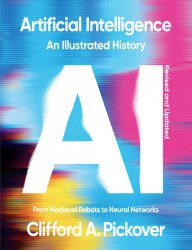 Название: Artificial Intelligence: An Illustrated History: From Medieval Robots to Neural Networks, Revised Edition
Название: Artificial Intelligence: An Illustrated History: From Medieval Robots to Neural Networks, Revised EditionАвтор: Clifford A. Pickover
Издательство: Union Square & Co.
Год: 2024
Страниц: 240
Язык: английский
Формат: epub
Размер: 37.3 MB
A History of the Future that's Happening Right Now.
Artificial Intelligence: An Illustrated History explores the historic origins and current applications of AI in such diverse fields as computing, medicine, popular culture, mythology, and philosophy. Through more than 100 entries, award-winning author Clifford A. Pickover, offers a granular, yet accessible, glimpse into the world of AI—from medieval robots and Boolean algebra to facial recognition, and artificial neural networks. First released in 2019, this updated paperback edition brings readers up to speed with coverage of technologies such as DALL-E and ChatGPT, and it explores the very real fear that AI will alter the course of humanity—forever.
As you read this book, remember that even if we consider some of the historical ideas or predictions concerning artificial beings to be far-fetched, old ideas may become suddenly viable when implemented on faster, more advanced computer hardware. Our technical predictions—and even our myths—are, at a minimum, fascinating models of human understanding and creativity—and of how we reach across cultures and time to understand one another and learn about what we hold sacred or beneficial for society. However, even as we celebrate human imagination and ingenuity, it is vital to discuss unintended consequences, including the possible dangers of AI. As theoretical physicist Stephen Hawking told the BBC in a 2014 interview, “The development of full artificial intelligence could spell the end of the human race.… It would take off on its own, and redesign itself at an ever-increasing rate.” In other words, there’s a chance that AI entities will become so smart and capable that they will be able to continually improve themselves, creating a kind of superintelligence that could pose a great risk to humanity. This form of runaway technology growth, sometimes referred to as the technological singularity, could result in unimaginable changes to civilization, society, and human life.
So while the potential benefits of AI are numerous—self-driving cars, efficient business processes, and even companionship in countless arenas—humanity will need to be particularly cautious when developing autonomous weapons systems and over-relying on AI technologies with sometimes inscrutable mechanisms. For example, studies show the ease with which some AI (neural net) imaging systems can be “tricked” into misidentifying animals as rifles, or a picture of a plane as a dog, by altering images in ways that humans cannot perceive. If a terrorist can make a mall or a hospital look like a military target to a drone, the consequences could be dire. On the other hand, perhaps armed machines with appropriate sensors and rules of ethics could also reduce civilian casualties. Informed policy-making is needed to ensure that the potential dangers of AI entities do not overshadow their amazing benefits.
As we increasingly put our trust in AIs with many complex deep learning neural networks, one interesting area of research is developing AI systems that can explain to humans how they arrived at certain decisions. However, forcing AIs to explain themselves could potentially cripple them, at least in certain applications. Many of these machines can create far more intricate models of reality than humans could possibly understand.
Скачать Artificial Intelligence: An Illustrated History: From Medieval Robots to Neural Networks, Revised Edition